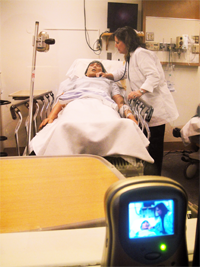VHA SimLEARN
Video baby monitor increases simulation realism without big price tag

By Bryan Cruthirds, RN, BSN, MBA, Simulationist/ Educator; Paula Carvalho, MD, FCCP, Medical Director of Simulation; Merry Kuyper-Carson, RN, MSN, ACNS/ Education, Nursing Director of Simulation; Ellen Jones, RN, BSN, Simulationist/Educator Boise VA Medical Center
BOISE, ID -With tight budgets in mind, the Boise VA Medical Center (BVAMC) was looking for a way to enhance in-situ simulation. The mannequin used during mock codes in the hospital units included a wireless transmitter for voice, but it lacked an acceptable way to hear or see what was happening in the room without physically being at the bedside. Some facilities have tried using a standard baby monitor during simulation, to enable the mannequin operator to hear what was happening and to respond appropriately. The simulation education team here decided to use a color video and audio baby monitor instead. With the ability to see, as well as hear what was happening real-time during the simulation, the benefits were observed immediately.
Using an IV pole mount, the team made a bracket that allowed the camera/microphone unit to be placed at the foot of the bed. During the first mock code on the BVAMC medical/surgical unit, the mannequin operator was able to see the learner’s physical touch on the “patient” when inquiring about pain location, and in turn, could cause the “patient” to respond appropriately to the actions of the learner. Because both the mannequin and the baby monitor were wireless, the operator was able to control the simulation and respond to the learner’s actions from two rooms away. Being able to remotely run in-situ scenarios without immediate physical presence at the bedside opens up many options and increases the realism of training.
Additional benefits to this particular baby monitor are the ability to see in the dark using infrared light (which would allow for continuous monitoring during “power outage” scenarios); battery or AC adapter operation; and the ability to record and capture images and sound from the monitor onto an attached computer. Using a USBto-RCA converter, both still images and video footage were captured during simulations. While the video quality is not as sharp as standard video cameras, the ability to see and respond appropriately and to use the videos during debriefing, if desired, made this purchase well worth the money.
(Cutline for photo) Ellen Jones, RN BSN, a nursing education specialist at the Boise VAMC, participates in a simulation exercise using the baby monitor. The camera is mounted on an IV pole on the opposite side of the bed. The monitor isvisible bottom right. (VA photo by Bryan Cruthirds)



















